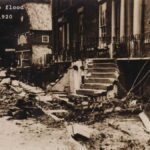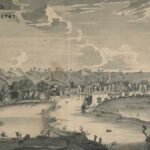Glimpse history through old images of Horncastle in Lincolnshire, England.
Tea Pot Hall in 1938
Tea Pot Hall in Horncastle was last lived in by a family in the 1920s. Rumoured to be a seventeenth century building, it was destroyed by fire not long after this film was made.
Downstairs, there was just one room. The room in the loft was accessed by a ladder.
No one seems sure why the triangular house was built this way, but it attracted painters and photographers several times over its long life.
Triangle House Aka Trainele House (1938) – British Pathé (YouTube)
A bit of Horncastle history
Extract from: Post office directory of Lincolnshire, by Kelly’s Directories, ltd
Published in 1885
Pages 484 – 485
HORNCASTLE is a market and union town, head of a county court district, parish and terminus of a line from Kirkstead, on the Lincoln and Boston branch of the Great Northern railway.
It is the capital of the soke of Horncastle, in the Mid division of the county, parts of Lindsey, and gives name to a rural deanery, in the archdeaconry of Stow and diocese of Lincoln: it is situated in a valley at the foot of the hills called the Wolds, on the rivers Bain and Waring, principally situated within an angle formed by the confluence of those rivers, 21 miles east from Lincoln, 136 from London by road and 130 by Great Northern railway, 10 north – west from Spilsby, 15 north from Alford, 20 north from Boston and 13 south – west from Louth.
In 1792 an Act was obtained for canalizing the river Bam from here to the river Witham, at Tattershall, a distance of 10 miles, the authorized capital being £15,000, in 20 shares: in 1800 another Act was obtained to raise an additional £20,000.
A good trade is carried on in coal and corn, malting and brewing.
The railway was opened on the 12th of August, 1855: it joins the Lincoln and Boston line at Kirkstead, thus opening a communication with all parts of England.
The manor, as in Domesday Book, was in possession of William the Norman.
Henry III. in the fourteenth year of his reign, granted three charters, one for a free warren, one for an annual fair and one to try felons and hold a court leet.
The town is, almost without doubt, built on the site of the Roman station ” Banovallum, ” and derives its name from the Saxon Hyrn-Ceaster, referring to the horn shaped piece of ground on which the town is built; the arms of the town, representing a ” horn ” and a ” castle, ” maintain the tradition.
Several British urns and fragments of bones and cinerary Roman urns have been found south east of the town, numerous coins of the Lower Empire and some fine specimens of the earlier Imperial coins, as well as Early English silver currency.
The Romans erected on this spot a very strong fort, enclosing an irregular parallelogram 600 feet long by 350 wide, on its eastern side, and 30 the western, with a wall 16 feet thick, and portions of a four walls, in some parts as much as 12 feet high, still exist. The date of the masonry may be generally assigned to A.D. 78, before the close of the reign of Vespasian, to which Emperor the earliest coins found here belong; the Romans appear also to have constructed at least three roads, leading from the station to the west, north and east, and perhaps two others southwards.
The town has been much improved; it is paved, lights with gas and abundantly supplied with water, and is under the Local Government Act, the board consisting of 12 members.
The church of St. Mary is a building chiefly in the Decorated and Perpendicular Styles, consisting of large chanel with aisles, nave of four bays, aisles, north and south porch, vestry and an exceedingly massive square embattled tower with spire containing 6 bells and a clock: the north aise was rebuilt in 1820, the south in 1821: the nave appears to belong to the Earlier half of the fourteenth century, with a clerestory added in the fifteenth century, the chancel is of about the same age as the nave, but the north aisle or chantry is later; the earliest remaining portion of the church is comprised in the arches and piers supporting the tower which date from the latter part of the thirteenth century.
The church was thoroughly restored in 1860, under the direction of Mr. Ewan Christian: the chancel, by James Banks Stanhope esq. and the rest by subscription: the interior was fitted with open oak benches and a new out roof erected; the cost of restoration was about £4,000: the organ was rebuilt, at a cost of £2,000, through the magnificence of Henry J. Fielding esq. and contains three manuals fine pedal organ, 45 stops and upwards of 2,500 pipes.
In the chancel is a handsome reredos, of Caen stone, elegantly carved; the eagle lectern of bronzed iron was the gift of the Rev.Saml. Lodge M.A.rector of Scrivelsby, and head master of Horncastle Grammar School, 1854-70: the ancient carved screens have been re – erected in the chancel, and the piscina on the south side restored: the east window is a memorial to the late Rev. H. Milner, vicar of Horncastle.
In the north aisle is a mural brass, on a slab of Purbeck marble, to Sir Lionel Dymoke, with kneeling figures of himself, two sons and three daughters: on the pavement is another brass representing the body of Sir Lionel in a shroud, with two scrolls and an inscribed brass below: in the north chancel aisle is a monument with arms to Sir Ingram Hopton kt. killed at Winceby, October 11th, 1643: in the south aisle is a memorial, reproduced with much care from the original painting on the south arcade wall, to the Rev. Thomas Gibson A.M. 44 years vicar of this parish, 1678, with a shield of arms: besides the east window there are others to the Rev. Robert Giles, a former vicar, and to Mr. Frederick Harwood: the south – east window is stained, in memory of the Rev. A. Scrivener, late vicar of this parish.
The parish register dates from 1559.
The living is a vicarage, net yearly value £675, including 370 acres of glebe, with residence, in the gift of the Bishop of Lincoln, and held since 1882 by the Rev. Edwin Fowler Quarrington M.A. of St. Catharine’s College, Cambridge.
A chapel of ease, named the Holy Trinity, in the Early English style was built, partly by public subscription and partly by a legacy of 500, bequeathed for that purpose by Dr. Madely, the late vicar: it was opened for divine service in Easter week in 1848: it consists of chancel, nave, aisles, north porch and high open belfry containing 1 bell, and is capable of containing about 400 persons; all the sittings are free.
There are Wesleyan Methodist, Congregational, Baptist and Primitive Methodists chapels.
George Whelpton, a native of Horncastle, erected in Queen street six almshouses for poor persons of the town in memory of his wife, with an allowance of as. 6d. a week, the endowment arising from £ 1.500 invested in the funds; the inmates are nominated by the vicar and churchwardens.
Hursteroft’s and Snowden’s charities are for apprenticing orphan boys belonging to the parish: the income about 100 yearly: other charities, the principal of which, amounting to 60 a year, are for distribution.
The Court House, North street, is a spacious building of brick and stone, fitted up with the usual offices: special and petty sessions for the Horncastle division of the parts of Lindsey are held here every saturday. The meetings of the Commissioners of Taxes and the County Court are also held in the same building.
The market, held on Saturday, is well supplied with poultry and other provisions; and five annual fairs are held, the first, on the fifth Thursday in Lent, for cattle and sheep; the second, on the 21st, for horses, and 22nd of June, for cattle; the third, the great horse fair, now confined to one week, commences on the Monday after the 8th of August, for sheep on the Thursday, and for cattle on Friday in the same week; this is considered to be one of the largest horse fairs in the kingdom, and is resorted to by dealers from all parts of England and the Continent; the fourth fair is for foals and sheep, and is held on the second Thursday of September; the fifth is for pleasure, cattle, horses and sheep, and is held on the 28th and 29th of October, and was removed here upon payment of 200, from Market Stainton in 1768.
The butter market, erected at the expense of James Banks Stanhope esq. was opened November 15th, 1853.
The Dispensary, established in 1789 by the late Drs. Harrison and Fawssett, is a great benefit to the town and neighbourhood: it is supported by donations and subscriptions, and collections made at all places of worship in the town: the average number of patients is about 1,000. A building for the dispensary was erected by subscription as a memorial of Sir Henry Dymoke bart.: it stands opposite the Court House and is of white brick with stone dressings.
A handsome Corn Exchange, situated in the High street, was opened on the 5th of July, 1856: it is of brick, with stone facings, and will hold 500: the cost was about £ 3.500. Concerts, lectures and assemblies are held here.
The Mechanics Institute, which occupies two rooms adjoining the Corn Exchange, was founded in the year 1836: it has now a good general library of about 2,500 volumes, in which is included the special reference library purchased out of a bequest of the late Henry Fielding esq. in 1879: there is a news room which is supplied with all the principal papers: the number of members is 250; the Rev. J. C. Hudson, vicar of Thornton, is librarian, and takes an active part in the management.
On the south – western side of the town, near the castle, is the Julian Bower close, the site of a maze of Roman origin, long since effaced by cultivation: many urns, coins, fibula and other Roman remains have been at different periods discovered here.
At the south – eastern part of the parish, near the mill on the Marcham road, is Hangman’s Corner, where those found guilty of capital offences in the court of the manor were formerly executed.
J. Banks Stanhope esq. is lord of the manor and principal landowner.
The area of the parish is 1,868 acres; rateable value, L13.625; the population in 1881 was 4,818, including 119 officers and inmates in the workhouse.
By the Act 44 Vic. e. xvii. the Fen Allotment was transferred to the new parish of Wildmoor. Parish Clerk, John Coats Osborne. Sexton, Francis Dawson.
More about Lincolnshire
- Old Images of Lincolnshire, England
- Old Images of Louth, Lincolnshire
- Old Images of Immingham, Lincolnshire
- Old Images of Grantham, Lincolnshire
- Old Images of Gainsborough, Lincolnshire
- Old Images of Crowland, Lincolnshire
- Old Images of Boston, Lincolnshire
- Old Images of Scunthorpe, Lincolnshire
- Old Images of Harlaxton Manor, Lincolnshire
- Old Images of Spalding, Lincolnshire
- Old Images of Skegness, Lincolnshire
- Old Images of Scampton, Lincolnshire
- Old images of Cranwell, Lincolnshire
- Old Images of Sleaford, Lincolnshire
- Old Images of Horncastle, Lincolnshire
- Old Images of Stamford, Lincolnshire
- Old images of Keadby Bridge, Lincolnshire


















